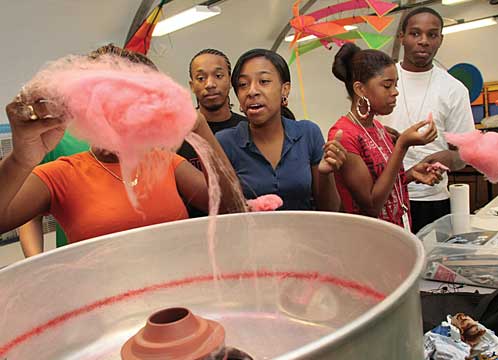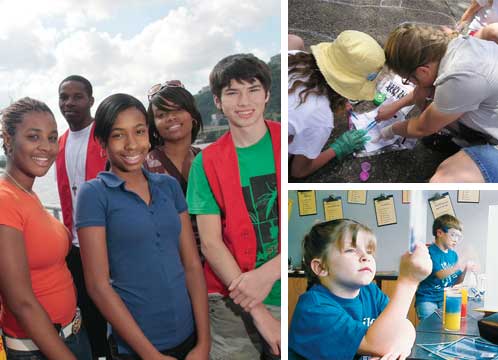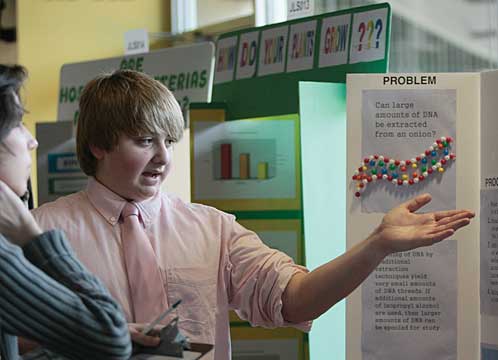 |
||
Lisa and Emma Roudabush at Lisa’s work place, U.S. Steel’s Mon Valley Works in Braddock. A love for science is a family affair. At just 14, Emma, who has an interest in the life sciences, has her eyes set on Carnegie Mellon University. |
Dream Machine
Carnegie Science Center is expanding a task long at the core of the Science Center’s mission—getting kids excited about science and technology —by doing more of what they do best: helping kids dream big about the real-world impact these subjects can have on their lives, and the region. Right now, you can find jobs in Pittsburgh. Good jobs that pay the kind of money your grandfather wouldn’t have earned at a steel mill in five years of backbreaking work—with double overtime. Yet, alarmingly, they’re positions for which many Pittsburghers don’t qualify. At least not yet.
“I got involved because I wanted to help younger children know that it’s okay to like science and be smart. I wanted them to know that they can become a scientist or anything else they wanted to be. You don’t have to settle for less than your dreams.”
-Mareena Moore, former Science in Your Neighborhood mentor, Photo: Lisa KyleAlready, nearly 50,000 people work in high-tech jobs in Allegheny and the four surrounding counties, according to a recent survey by the American Electronics Association (AEA). This ranks Pittsburgh at 27 out of 60 top U.S. cities in terms of high-tech brain power. Better yet, high-tech jobs are increasing regionally by 3 percent a year. They’re where the money’s at, too. On average, the AEA reports that local high-tech workers earn $67,100, or about 66 percent more than their private-sector, non-tech counterparts. The major downside—one that the Science Center, the Pittsburgh Public Schools, and other important regional stakeholders are actively working to reverse—is that many of those tech jobs go unfilled for weeks and months due to a lack of qualified candidates. A fact all the more puzzling considering that Pittsburgh is the home of world-class universities touted for their outstanding science and high-tech programs and top-notch graduates. And we’re not alone. Microsoft will soon open a training school in British Columbia just to prepare workers for 3,000 unfilled jobs at the software giant’s home base in Richmond, Washington. And high-tech lobbyists in the nation’s capitol are practically begging legislators to revamp immigration laws to allow more foreign scientists and technologists to enter the country to ease the talent shortage. As American high-tech companies search for qualified help, what role can schools, science centers, private companies, and government play to develop the nation’s next generation of scientists? Dream. Discover. Design.Recent studies from every source imaginable show that, starting as early as the fourth grade, American students lag behind schoolboys and girls around the world in terms of science achievement. Former U.S. Secretary of Education Rod Paige lamented that only 18 percent of the nation’s high-school seniors are proficient in the sciences.“In the future, people who don’t understand science simply won’t be able to contribute as much to society as those who do,” says John Radzilowicz, director of visitor experience at Carnegie Science Center.
Mareena Moore with Science Center Youth Apprentices; teens from the Girls, Math & Science Partnership at Click! summer camp; and a young scientist at work at the Science Center.Locally, the Science Center—joined by its sister museums, neighboring schools, businesses, and other educational institutions—is constantly exploring better ways to prepare the region’s children for a life of scientific achievement. These days, Radzilowicz notes, no science teacher is an island. Even the best-equipped schools can’t provide the variety of scientific experiences that are available to students beyond their classroom walls.“The Science Center model has long focused on interacting with the community,” Radzilowicz continues. “And we’re always changing what we do, based on the changing needs of the community.” One of the biggest changes ever is just around the corner, as the Pittsburgh Public Schools confronts the challenge of developing the next generation of science-savvy adults. Since 1979, the city’s School for Creative and Performing Arts has provided young people with a training ground for a life on stage, in the studio, and in the entertainment executive suite. Building on that success, the city schools will take a quantum step forward in helping to relieve the shortage of scientists and technologists by opening the Pittsburgh Science and Technology Academy magnet school for the 2009-10 academic year. Set to accept up to 550 students in grades six through 12, the new school, located at the Frick Middle School in Oakland, will help prepare young people for college majors and careers in science and technology. While the Science Center will not house the academy, as once considered, it has contributed to the design process and will continue to play a role in its development. Sam Franklin, the district’s project manager for the new school, says all four Carnegie Museums will help the Science and Technology Academy bring to life its theme of “Dream. Discover. Design.” “The dream component of the school is designed to generate excitement among students about science and technology,” says Franklin. “The Science Center does that very well every day with its exhibits and programs. The discovery element deals with research. The team of scientists at Carnegie Museum of Natural History is involved in research every day, so we’ll look to them for help. And while the Science Center doesn’t do research, it does communicate it very well. The ability to communicate the results of their research is something our students must be able to do if they are to succeed. “Finally, in the design phase, the staff at the Science Center and the other museums will help our students apply their research to creating real exhibits that will be displayed at the school and even in the museums. Overall, the entire Carnegie Museums system brings to us a well-known reputation in science communications and discovery.” One goal unites the many partners in this worthwhile venture, Radzilowicz points out: “We’re all in this to provide students the broadest possible exposure to science, make them lifelong learners, and prepare them for life after school.” A life where, as the Science Center often says, science happens every day, all around us. Everyone’s ScienceThey’re scenes science teachers would give their left Bunsen burners to replicate: A group of giddy teenage girls transformed into serious scientists, whipping up their own batch of chemical-free lip balm after discovering that 65 percent of the lipsticks on the market contain lead, and the average woman will swallow three pounds of lipstick during her life. Or, during a summer camp designed specifically with them in mind, a small group of pre-teen girls studies the environmental health of the city’s three rivers and sends the mayor a list of recommendations for improving the cleanliness of the Ohio, Monongahela, and Allegheny rivers.These projects are the product of the high-impact effort of the Science Center’s Girls, Math & Science Partnership (GMSP), whose executive director, Jennifer Stancil, is actively involved with the new magnet school as part of its external communications committee. Originally created through collaboration between The Heinz Endowments, the Alcoa Foundation, and Family Communications, Inc., with the goal of addressing the unique ways that girls process information and learn, the partnership moved to the Science Center in late 2005. GMSP provides an encouraging environment that engages 11-to 17-year-old girls—the ages when many young women begin to lose interest in science and math. As many as 20,000 girls, teachers, and mentors participate in person or online, locally and nationally. “Girls can have jobs in science and math,” says Lisa Roudabush, who, as the general manager of U.S. Steel’s Mon Valley Works, is living proof of her beliefs. “It’s not a matter of boys’ jobs and girls’ jobs. What anyone can get out of a science or math career is the challenge of investigating and solving problems. That’s what people do every day in those fields.” Roudabush says she feels obligated, like the Science Center, to help more girls get excited about science and math careers. “The Science Center does a great job of showcasing Pittsburgh as a region of technology careers. As the mother of a teenage daughter, I’m excited about being involved with the Science Center because I can encourage her and her friends to think about science as a career through hands-on activities they participate in. “It’s my responsibility as a woman in science to bring more women and more minorities into engineering, science, and math jobs,” says Roudabush, who also sits on the Science Center’s board of directors. “Every company needs the resources, the diversity of thought, and the variety of experiences that women can bring to the job. If I overlook that portion of the market, I’m letting down my company and the women who could be working here.” The Fun of ScienceBringing science alive—in a way that appeals to kids—is what the Science Center considers not only its strength, but its responsibility. And it has a long track record of success, through not only its exhibits but a variety of special on- and off-site programs for kids of all ages, for schools and families, as well as the regional tech community.Next spring will mark the 70th anniversary of the Pittsburgh Regional Science and Engineering Fair, an open competition for middle and high school students organized by the Science Center. One of the nation’s oldest events of its type, the fair welcomes students from 26 counties within western Pennsylvania and West Virginia who vie for more than $750,000 in cash awards, scholarships, and trips. Co-sponsored by local corporations, the experience gives students real-life experience creating scientific projects and showcasing their learning. This year, more than 1,000 students participated. Through its marquee Science on the Road program, the Science Center takes its science-is-fun approach to learning into classrooms and auditoriums in schools near and far—even as far as New York state and Virginia Beach, Maryland. Last school year, nearly 200,000 students experienced Science on the Road shows—think high-energy, hands-on experiments that include dry ice, colorful explosions, and shattering glass—covering a variety of content, from sound waves to space travel, heat and combustion to human growth and development. “It’s a really dramatic way for students to see how science works,” says Jessica Lausch, director of education experiences at the Science Center. “We want students to think of science as being cool and fun and exciting.”
More than 1,000 kids participated in this year’s Pittsburgh Regional Science and Engineering Fair.“The Science Center is a real gift to parents and students in this area. It makes science real and accessible. … Areya is proof of the difference the Science Center can make.” - Parent Stephanie Simmons
Creating the SparkWhen Stephanie Simmons moved to a small Somerset County town, she knew that she needed to find a way to keep her young daughter Areya interested in science. In a school district that graduated only about 50 to 60 high school seniors annually—with many choosing careers in the military or retail—she was well aware that sparking an 11-year-old’s interest in learning would be a tough challenge. “We lived in an area that didn’t have good access to and couldn’t afford the technology that was available to other schools,” says Simmons, an environmental wastewater consultant. “So on Areya’s 11th birthday, I rented a limousine to take her and a few friends to the Science Center for a party. It was the start of a great experience.” That birthday adventure turned out to be a gift with a lasting impact. And after Areya and her mother moved closer to Pittsburgh, Areya become a regular at the Science Center. As her interest in science accelerated, the types of programs she got involved with grew more complicated and rewarding. “I remember a Girl Scouts sleepover where no one slept because we were too excited about seeing all the exhibits and having fun,” recalls Areya. “But the best part was the Bayer C.A.U.S.E Challenge in 2005 (a high school film festival with a science and technology focus). I got involved by making a five-minute documentary about the effects of mercury contamination on the environment, and discovered I had a passion for helping to make people’s lives better through filmmaking.” That short film had a big effect on her life. After winning the “Viewer’s Choice” award during a screening at the Pittsburgh Filmmakers Harris Theater, Areya entered the work at the International Indigenous Film Festival in Denver, where it was viewed by 1,500 fellow Native American youngsters. Today, Areya’s pursuing her passion as a film and television production major at the Savannah College of Art and Design in Georgia, thanks to a fully funded scholarship from the Bill and Melinda Gates Foundation—an award that Areya’s mother gives credit, in part, to the Science Center. “The Science Center is a real gift to parents and students in this area,” says Simmons. “It makes science real and accessible. There are so many people who have to travel three and four hours one way to get to a place like the Science Center. That’s why I tell everyone to take advantage of such a great resource so close to home. Areya is proof of the difference the Science Center can make.” It Takes a VillageMost educators agree that it takes active participation by not only teachers and students but parents and other mentors to ignite a real desire to learn among kids. Two Science Center programs, Mission Discovery and Science in Your Neighborhood (SIYN), stand as award-winning examples of exactly that. (The Science Center’s 2003 award for outstanding outreach, from the Institutes for Library and Museum Services, was in large part due to these programs.) Part of the requirement for participation in Mission Discovery, a year-round program based at Pittsburgh’s Hill House, is that parents actively be involved. Together, parents and their middle schoolers take advantage of activities centered around math, science, technology, and the arts through programming at all four Carnegie Museums. In SIYN, it’s the older kids who do the mentoring. The program trains and employs high school students to work with elementary students in inner city neighborhoods about four hours a week. In many cases, the older students are graduates of SIYN, or other Science Center outreach programs who then return to instill their passion for science in younger children. That inspiration sometimes pays a double dividend as older kids provide a positive example to younger children and continue to study science beyond high school. “I started in Mission Discovery when I was in ninth grade,” says Mareena Moore, a former SIYN mentor who’s now a sophomore majoring in elementary education at Edinboro University. “After that I got involved with Science in Your Neighborhood because I wanted to help younger children know that it’s okay to like science and be smart. I wanted them to know that they can become a scientist or anything else they wanted to be. You don’t have to settle for less than your dreams. That’s what the program taught me, and other kids who are part of it.” “We train kids to think critically, so that they can transfer their skills across a variety of fields,” adds Jessica Lausch. “Mareena is a wonderful example of the type of student we’re reaching out to, and what they can accomplish. Mareena has showed every student in Science in Your Neighborhood that it’s okay to like science and to work hard and succeed in school.” Another shining example, Areya Simmons, echoes those sentiments, and urges other students to follow their interests in the sciences, and develop one special talent. “Your imagination is the most powerful tool you ever have in your life,” she says. “The Science Center is a master of bolstering that imagination through science. You learn there without even knowing that you’re learning. You can dream big. And the Science Center is the place where you can start your dreams.” |
|
Burb Appeal · Transformers · Speaking Their Language · President's Note · NewsWorthy · Now Showing · Face Time: Andy Mack · Artistic License: In the Name of Hybrid Theater · Science & Nature: The Herp House · About Town: A Road Map to Scientific Treasure · Another Look: The Child Mummy
 |
Copyright © 2017 CARNEGIE Magazine. All rights reserved. |



